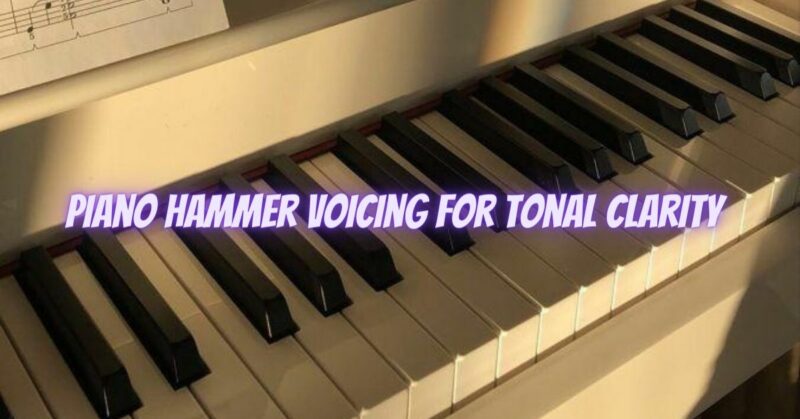Tonal clarity is a crucial aspect of piano sound that allows each note to be distinct and well-defined. When voicing piano hammers for tonal clarity, the goal is to create a balanced and transparent sound, where individual notes can be heard clearly even in complex passages. Achieving tonal clarity involves careful adjustments to the hammers to ensure that each note has a consistent and focused tone. Here are some essential techniques for voicing piano hammers to achieve tonal clarity:
- Hammer Felt Selection: The choice of hammer felt plays a significant role in tonal clarity. Pianists often opt for harder felt materials that provide a clearer attack and quicker release of the strings. Harder felt enables the hammers to produce cleaner and more articulate tones, enhancing the piano’s overall clarity.
- Voicing Technique: Voicing for tonal clarity involves shaping the hammers to create a flatter and more even striking surface. This shape allows the hammers to make clean and precise contact with the strings, resulting in a focused and well-articulated sound. Voicing techniques also include needling the hammer felt to improve its responsiveness and control.
- Regulating Key Action: Proper regulation of the piano’s key action is essential for tonal clarity. This involves adjusting the alignment and timing of various components to ensure that each hammer strikes the strings uniformly. Proper regulation contributes to a consistent and well-balanced sound across the keyboard.
- Listening and Refinement: Achieving tonal clarity requires attentive listening and constant refinement. Pianists should play a wide range of music and listen carefully for any unevenness or inconsistencies in the sound. Making precise adjustments to the hammers based on the desired tonal qualities is essential to achieve clarity in the piano’s sound.
- Dynamic Expression: Voicing for tonal clarity should also consider dynamic expression. Pianists aim to maintain clarity and definition in the sound, even when playing at different volume levels. This involves voicing the hammers in a way that allows for clear articulation in both soft and loud playing.
- Regular Maintenance: Regular maintenance and voicing adjustments by a skilled piano technician are vital to maintaining tonal clarity over time. As hammers compact and wear with use, their voicing may change, affecting the clarity of the piano’s sound. Regular voicing ensures that the piano retains its tonal qualities and remains articulate.
- Synergy with the Piano’s Design: Tonal clarity is influenced not only by the hammer voicing but also by the piano’s overall design and construction. Each piano model has its unique characteristics, and the voicing process should take these factors into account. A collaborative approach between the pianist and the piano technician ensures that the voicing aligns with the piano’s design for optimal clarity.
In conclusion, voicing piano hammers for tonal clarity is a meticulous process that involves attention to detail and an understanding of the piano’s design. By selecting the appropriate hammer felt, using specific voicing techniques, and regulating the key action, pianists can achieve a clear and well-articulated sound. Regular maintenance and collaboration with a skilled piano technician ensure that the piano maintains its tonal clarity over time. With a well-voiced piano that offers tonal transparency and precision, pianists can bring out the intricacies in their performances, allowing the music to shine with clarity and brilliance.


